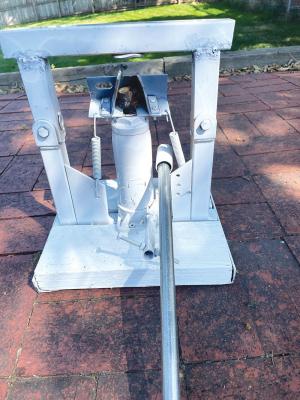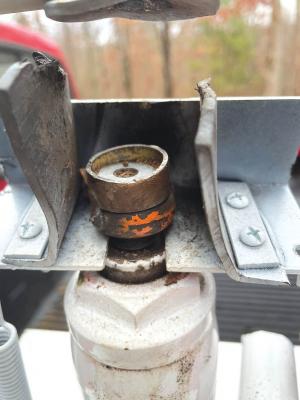2024 - Volume #48, Issue #1, Page #21
[ Sample Stories From This Issue | List of All Stories In This Issue | Print this story
| Read this issue]
Hydraulic Nutcracker Gets Job Done
 |
 |
“I love black walnuts, but the shells are hard to crack,” says Martin. “With my nutcracker, it’s easy. I pump the handle on the jack a few times until the nut cracks. Then, I release the pressure on the jack piston and pull out the cracked nut. It takes 20 to 30 seconds per nut.”
Martin started with square tubing from an old exercise machine. He took advantage of fittings on the tubing to assemble a U-shaped framework with 12-in. sides using bolts.
“If I ever need to, I can take it apart by removing one bolt on each side,” says Martin.
He welded a crossbar to the U, making the frame just 2 1/2 in. taller than the jack piston. He then welded the base of the frame to the centers of two 12-in. long, 1 1/2-in. angle irons. The angle irons provided a base to attach 12-in. long 2 by 6-in. boards. He drilled holes in the base of the jack so he could fasten it to the boards with screws.
“I hammered a large washer into a dish shape and welded it to the underside of the top crossbar to catch the nut,” explains Martin. “To hold the nut on top of the jack post, I cut a 1/4-in. slice of pipe and welded it to the top of the screw adjustment on the piston of the jack.”
To speed the downward movement of the piston when the hydraulic pressure is released, Martin fabricated a yoke for the top of the piston. He cut a slot out of a piece of bed frame angle iron and slipped it over the threads of the adjusting screw to rest on the piston of the jack.
“I welded two pieces of scrap to the bottom corners of the frame and drilled holes in them to attach springs which hook onto the yoke,” says Martin. “When I release the hydraulic pressure on the piston, the springs pull it down so I can remove and replace the cracked nut.”
After having the shell fragments sting his finger when cracking nuts, Martin added a piece of rubber baseboard to either side of the nut holder.
“I screwed them to the yoke, so they make a flexible pocket for holding the nut,” says Martin.
Martin made it easy to adjust the release valve on the jack. He cut a slot in a short length of pipe that fits over the valve and glued the pipe to the valve using JB weld. He then drilled a hole in the end of the pipe and inserted a small bolt through it, securing it with a nut on either side of the pipe. He also made a 2-ft. extension to the jack handle.
“I set the entire nutcracker in an old oil drip pan that I had cleaned up and set it on the workbench,” says Martin. “Any piece of nut or nutshell that flies off falls on the pan. There are no nutshells to sweep up. When I’m all done, I take the pan outside and dump it far from the house and let the squirrels search for walnut crumbs.”
Contact: FARM SHOW Followup, John Martin, 1012 Old Alabama Rd. SW, McDonald, Tenn. 37353 (ph 303-941-3778; johnmartin0012@hotmail.com).

Click here to download page story appeared in.

Click here to read entire issue
To read the rest of this story, download this issue below or click here to register with your account number.




